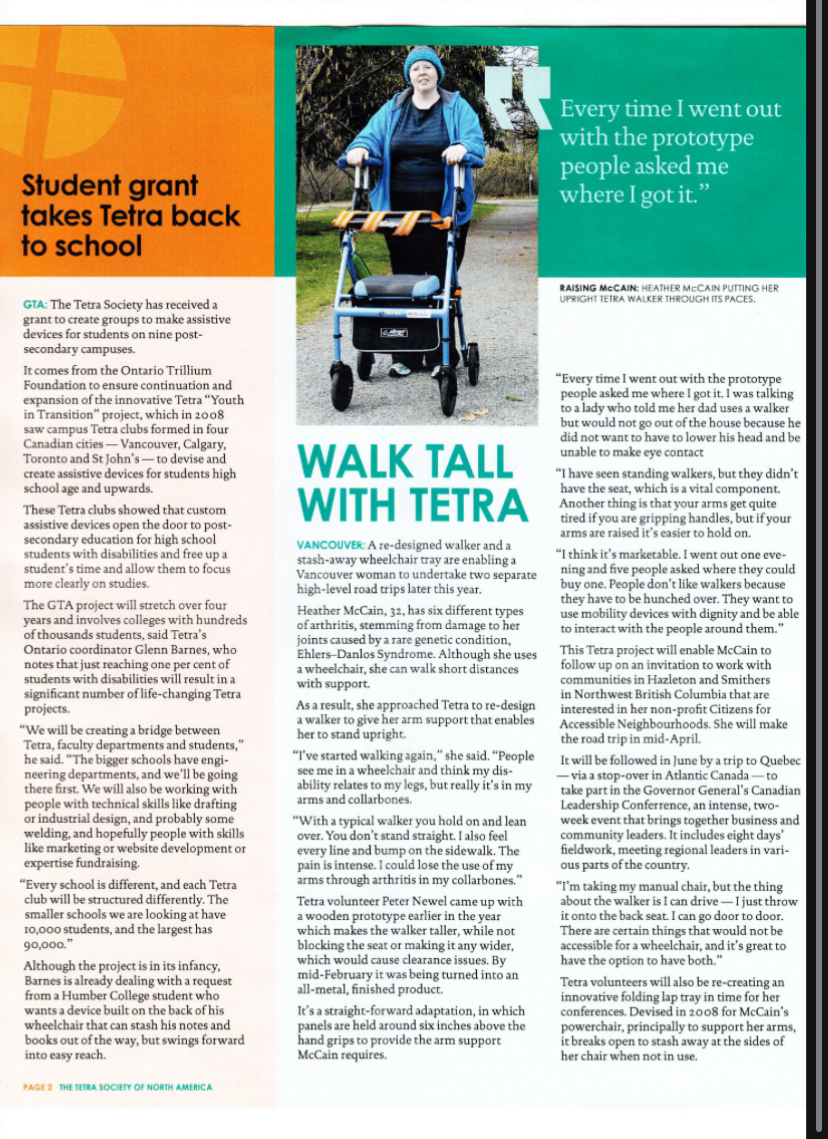
Student grant takes Tetra back to school
GTA: The Tetra Society has received a grant to create groups to make assistive devices for students on nine post-secondary campuses.
It comes from the Ontario Trillium Foundation to ensure continuation and expansion of the innovative Tetra “Youth in Transition” project, which in 2008 saw campus Tetra clubs formed in four Canadian cities — Vancouver, Calgary, Toronto and St John’s — to devise and create assistive devices for students high school age and upwards.
These Tetra clubs showed that custom assistive devices open the door to post-secondary education for high school students with disabilities and free up a student’s time and allow them to focus more clearly on studies.
The GTA project will stretch over four years and involves colleges with hundreds of thousands students, said Tetra’s Ontario coordinator Glenn Barnes, who notes that just reaching one per cent of students with disabilities will result in a significant number of life-changing Tetra projects.
“We will be creating a bridge between
Tetra, faculty departments and students,” he said. “The bigger schools have engineering departments, and we’ll be going there first. We will also be working with people with technical skills like drafting or industrial design, and probably some welding, and hopefully people with skills like marketing or website development or expertise fundraising.
“Every school is different, and each Tetra club will be structured differently. The smaller schools we are looking at have 10,000 students, and the largest has
90,000.”
Although the project is in its infancy, Barnes is already dealing with a request from a Humber College student who wants a device built on the back of his wheelchair that can stash his notes and books out of the way, but swings forward into easy reach.
VANCOUVER: A re-designed walker and a stash-away wheelchair tray are enabling a Vancouver woman to undertake two separate high-level road trips later this year.
Heather McCain, 32, has six different types of arthritis, stemming from damage to her joints caused by a rare genetic condition, Ehlers-Danlos Syndrome. Although she uses a wheelchair, she can walk short distances with support.
As a result, she approached Tetra to re-design a walker to give her arm support that enables her to stand upright.
“I’ve started walking again,” she said. “People see me in a wheelchair and think my disability relates to my legs, but really it’s in my arms and collarbones.
“With a typical walker you hold on and lean over. You don’t stand straight. I also feel every line and bump on the sidewalk. The pain is intense. I could lose the use of my arms through arthritis in my collarbones.”
Tetra volunteer Peter Newel came up with a wooden prototype earlier in the year which makes the walker taller, while not blocking the seat or making it any wider, which would cause clearance issues. By mid-February it was being turned into an all-metal, finished product.
It’s a straight-forward adaptation, in which panels are held around six inches above the hand grips to provide the arm support McCain requires.
“Every time I went out with the prototype people asked me where I got it. I was talking to a lady who told me her dad uses a walker but would not go out of the house because he did not want to have to lower his head and be unable to make eye contact.
“I have seen standing walkers, but they didn’t have the seat, which is a vital component.
Another thing is that your arms get quite tired if you are gripping handles, but if your arms are raised it’s easier to hold on.
“I think it’s marketable. I went out one evening and five people asked where they could buy one. People don’t like walkers because they have to be hunched over. They want to use mobility devices with dignity and be able to interact with the people around them.”
This Tetra project will enable McCain to follow up on an invitation to work with communities in Hazleton and Smithers in Northwest British Columbia that are interested in her non-profit Citizens for Accessible Neighbourhoods. She will make the road trip in mid-April.
It will be followed in June by a trip to Quebec via a stop-over in Atlantic Canada — to take part in the Governor General’s Canadian Leadership Conference, an intense, two-week event that brings together business and community leaders. It includes eight days’ fieldwork, meeting regional leaders in various parts of the country.
“I’m taking my manual chair, but the thing about the walker is I can drive-I just throw it onto the back seat. I can go door to door.There are certain things that would not be accessible for a wheelchair, and it’s great to have the option to have both.”
Tetra volunteers will also be re-creating an innovative folding lap tray in time for her conferences. Devised in 2008 for McCain’s powerchair, principally to support her arms, it breaks open to stash away at the sides of her chair when not in use.
